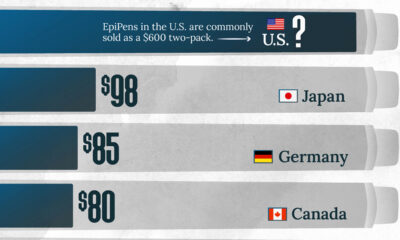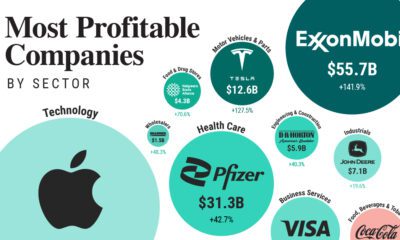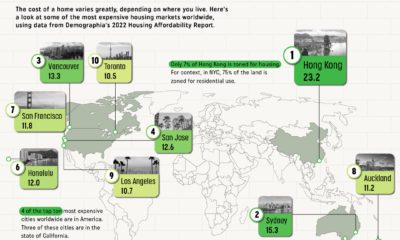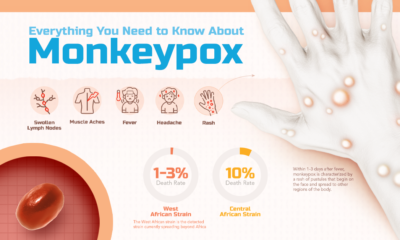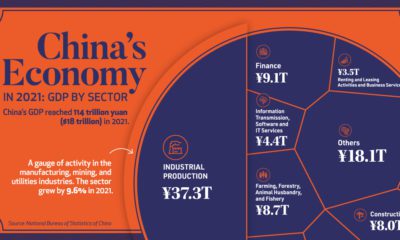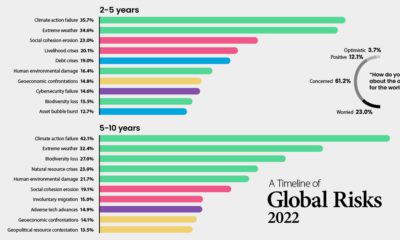COVID-19
Tracking COVID-19 Vaccines Around the World
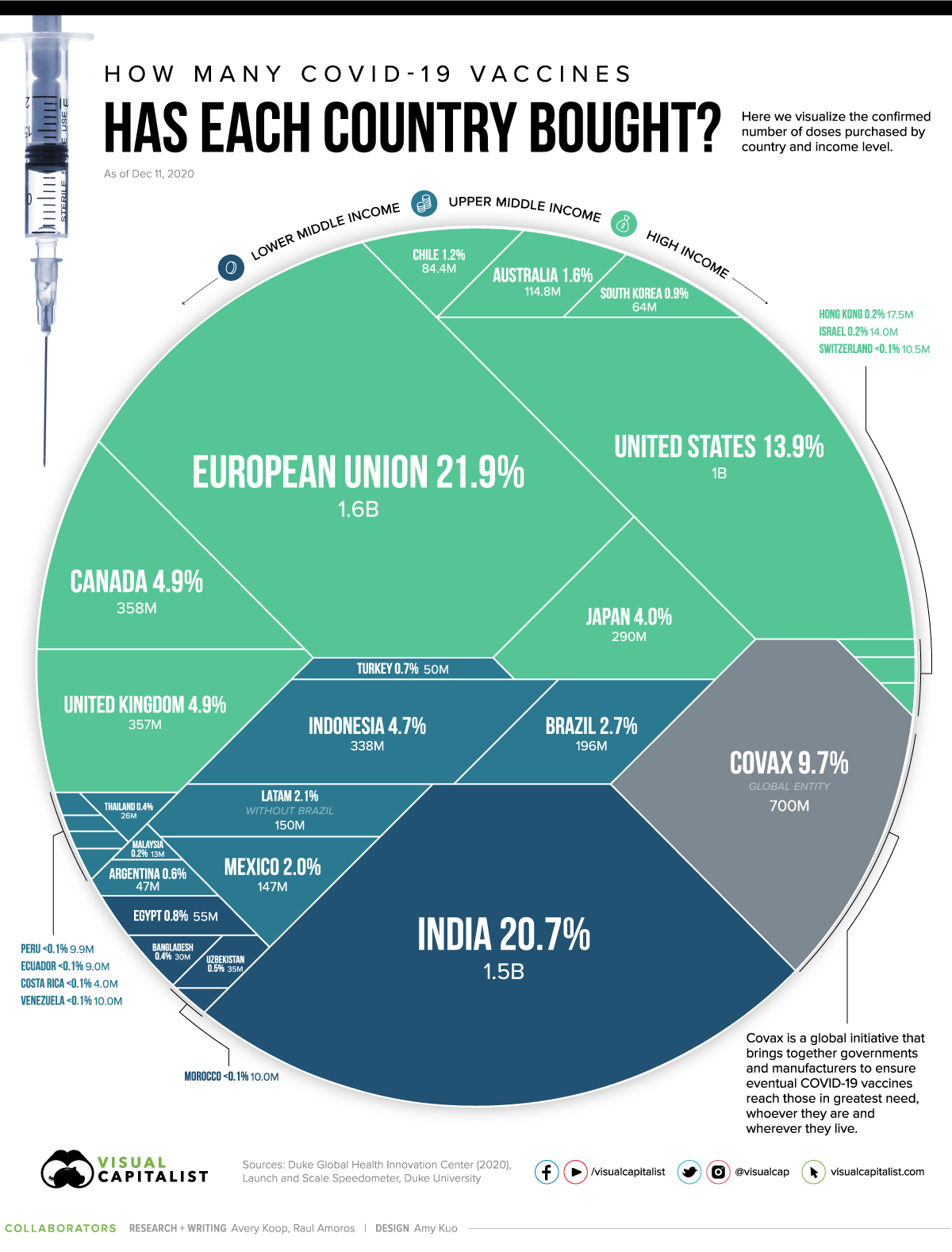
Tracking COVID-19 Vaccines Around the World
In November 2020, the world received the exciting news that the first COVID-19 vaccines were ready for roll out—and as of now, nearly 7.25 billion doses have been pre-purchased by countries and organizations around the globe.
Today’s visualizations highlight the number of vaccine doses that different countries have purchased, as well as the companies and organizations that have pre-sold them.
The data has been collected via the Launch and Scale Speedometer at the Duke Global Health Innovation Center with support from the Bill & Melinda Gates Foundation.
Breaking Down COVID-19 Vaccines by Country
Although high income countries are currently buying the larger shares of doses, India has ordered 1.5 billion—more than any other individual country.
The U.S., in comparison, has pre-purchased 1.01 billion doses, and although this number is less than the amount India has purchased, the U.S. has around 330 million people compared to India’s burgeoning 1.3 billion citizens.
| Country or Region | COVID-19 Vaccine Doses | % Global Share |
|---|---|---|
| European Union 🇪🇺 | 1,585,000,000 | 21.87% |
| India 🇮🇳 | 1,500,000,000 | 20.69% |
| USA 🇺🇸 | 1,010,000,000 | 13.93% |
| COVAX* 🌐 | 700,000,000 | 9.66% |
| Canada 🇨🇦 | 358,000,000 | 4.94% |
| UK 🇬🇧 | 357,000,000 | 4.92% |
| Indonesia 🇮🇩 | 338,000,000 | 4.66% |
| Japan 🇯🇵 | 290,000,000 | 4.00% |
| Brazil 🇧🇷 | 196,000,000 | 2.70% |
| Latin America W/O Brazil | 150,000,000 | 2.07% |
| Mexico | 146,800,000 | 2.03% |
| Australia | 114,800,000 | 1.58% |
| Chile | 84,400,000 | 1.16% |
| South Korea | 64,000,000 | 0.88% |
| Egypt | 55,000,000 | 0.76% |
| Turkey | 50,000,000 | 0.69% |
| Argentina | 47,000,000 | 0.65% |
| Uzbekistan | 35,000,000 | 0.48% |
| Bangladesh | 30,100,000 | 0.42% |
| Thailand | 26,000,000 | 0.36% |
| Hong Kong | 17,500,000 | 0.24% |
| Israel | 14,000,000 | 0.19% |
| Malaysia | 12,800,000 | 0.18% |
| Switzerland | 10,500,000 | 0.14% |
| Venezuela | 10,000,000 | 0.14% |
| Morocco | 10,000,000 | 0.14% |
| Peru | 9,900,000 | 0.14% |
| Ecuador | 9,000,000 | 0.12% |
| Costa Rica | 4,000,075 | 0.06% |
| New Zealand | 3,500,000 | 0.05% |
| Panama | 3,000,000 | 0.04% |
| Phillippines | 2,600,000 | 0.04% |
| Kazakhstan | 2,000,000 | 0.03% |
| Lebanon | 2,000,000 | 0.03% |
| Kuwait | 1,000,000 | 0.01% |
| Global Total (as of Dec 11) | 7,248,900,075 | 100.00% |
*COVAX is a global initiative to provide equitable access to COVID-19 vaccines
Without the purchasing power of high income countries, low and middle income countries must leverage other means to acquire COVID-19 vaccines, like volunteering to host clinical trials in exchange for doses, as was done in Peru. India’s ability to purchase so many doses has come out of manufacturing agreements with vaccine producers.
As a percentage of total doses sold, high income countries have bought almost 54%, equating to 4 billion doses. Meanwhile, low and middle income countries have purchased just over 23%.
Notably, Canada has reserved the highest number of doses per person compared to any other country, having ordered over 350 million vaccinations for a population of just over 38 million people, equating to nine doses per person.
The Business of COVID-19 Vaccines
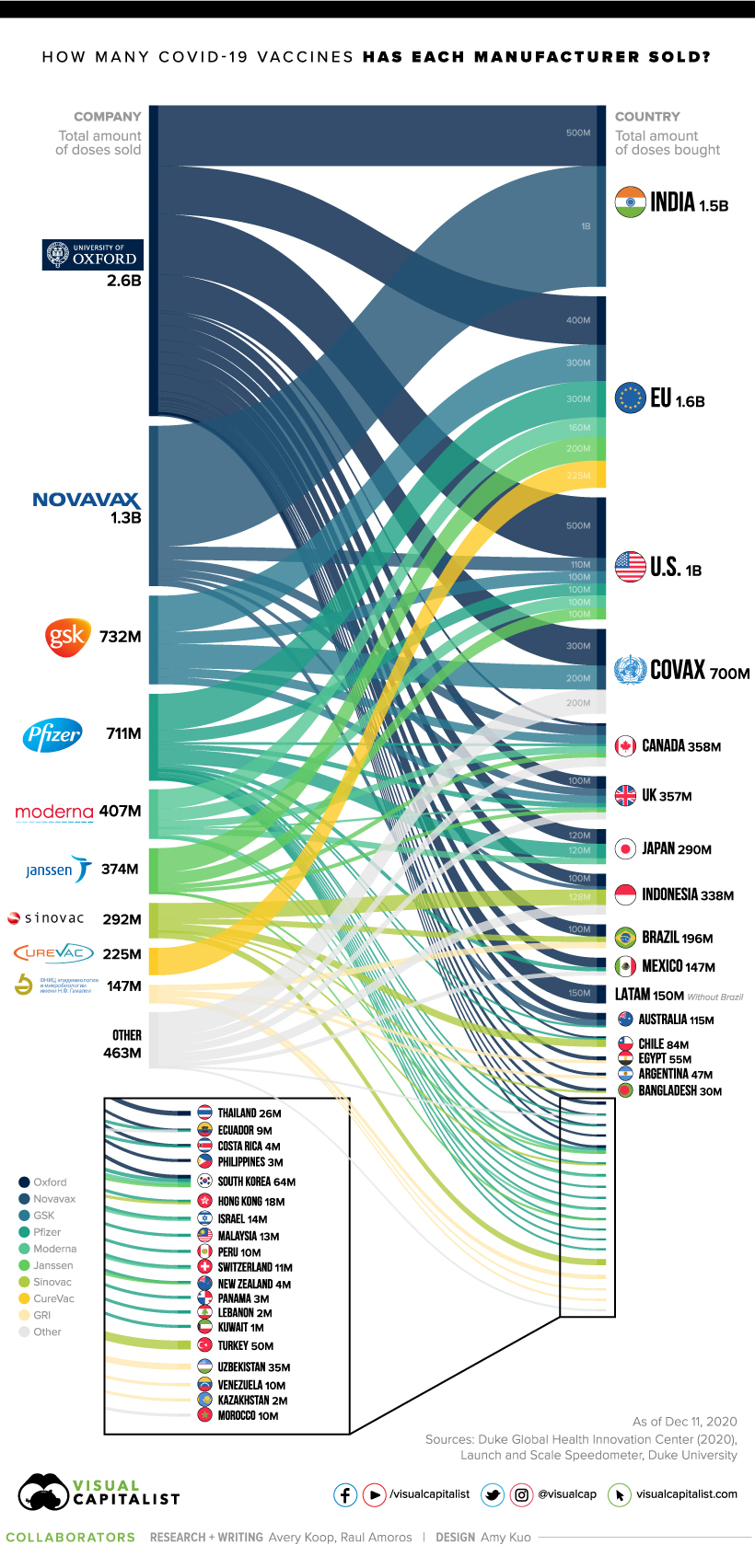
There are currently over 200 vaccine candidates being developed and tested at breakneck speed. However, one important aspect to note is that not all of the vaccine candidates that are being pre-sold will pass the testing stage.
The Oxford University vaccine is the most popular so far, with over 2.5 billion doses sold. The academic institution, together with AstraZeneca, is doling out 500 million vaccines each to India and the U.S., as well as 400 million to the European Union.
Novavax, the second highest seller of COVID-19 vaccines, has pre-sold 1.3 billion doses. So far, the early birds Pfizer-BioNTech and Moderna have pre-sold 10% and 6% of the total vaccine doses being manufactured respectively.
In terms of pricing, Pfizer-BioNTech, for example, is selling their vaccines at $19.50 per dosage. With the current number of doses already sold by Pfizer-BioNTech, that amounts to a current revenue of over $13 billion.
The Way Forward
Without COVID-19 vaccines, health and safety measures such as social distancing and self-isolation would likely stay in place for the foreseeable future.
Looking beyond which countries receive the vaccines first, the World Health Organization has created a road map detailing which individuals should be prioritized, with a focus on frontline healthcare workers and the elderly.
A future where life is somewhat back to normal is on the horizon, but some countries are set to get there faster than others.
Healthcare
Visualizing How COVID-19 Antiviral Pills and Vaccines Work at the Cellular Level
Despite tackling the same disease, vaccines and antiviral pills work differently to combat COVID-19. We visualize how they work in the body.
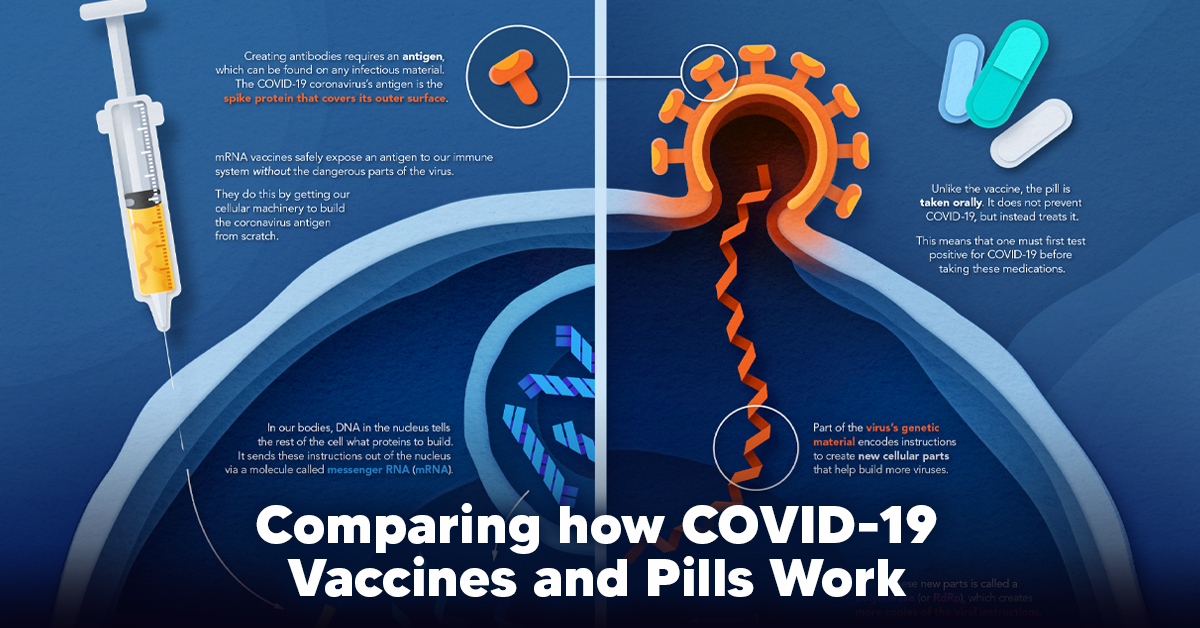
Current Strategies to Tackle COVID-19
Since the pandemic started in 2020, a number of therapies have been developed to combat COVID-19.
The leading options for preventing infection include social distancing, mask-wearing, and vaccination. They are still recommended during the upsurge of the coronavirus’s latest mutation, the Omicron variant.
But in December 2021, The United States Food and Drug Administration (USDA) granted Emergency Use Authorization to two experimental pills for the treatment of new COVID-19 cases.
These medications, one made by Pfizer and the other by Merck & Co., hope to contribute to the fight against the coronavirus and its variants. Alongside vaccinations, they may help to curb extreme cases of COVID-19 by reducing the need for hospitalization.
Despite tackling the same disease, vaccines and pills work differently:
| Vaccines | Pills |
|---|---|
| Taken by injection | Taken by mouth |
| Used for prevention | Used for treatment only |
| Create an enhanced immune system by stimulating antibody production | Disrupt the assembly of new viral particles |
How a Vaccine Helps Prevent COVID-19
The main purpose of a vaccine is to prewarn the body of a potential COVID-19 infection by creating antibodies that target and destroy the coronavirus.
In order to do this, the immune system needs an antigen.
It’s difficult to do this risk-free since all antigens exist directly on a virus. Luckily, vaccines safely expose antigens to our immune systems without the dangerous parts of the virus.
In the case of COVID-19, the coronavirus’s antigen is the spike protein that covers its outer surface. Vaccines inject antigen-building instructions* and use our own cellular machinery to build the coronavirus antigen from scratch.
When exposed to the spike protein, the immune system begins to assemble antigen-specific antibodies. These antibodies wait for the opportunity to attack the real spike protein when a coronavirus enters the body. Since antibodies decrease over time, booster immunizations help to maintain a strong line of defense.
*While different vaccine technologies exist, they all do a similar thing: introduce an antigen and build a stronger immune system.
How COVID Antiviral Pills Work
Antiviral pills, unlike vaccines, are not a preventative strategy. Instead, they treat an infected individual experiencing symptoms from the virus.
Two drugs are now entering the market. Merck & Co.’s Lagevrio®, composed of one molecule, and Pfizer’s Paxlovid®, composed of two.
These medications disrupt specific processes in the viral assembly line to choke the virus’s ability to replicate.
The Mechanism of Molnupiravir
RNA-dependent RNA Polymerase (RdRp) is a cellular component that works similar to a photocopying machine for the virus’s genetic instructions. An infected host cell is forced to produce RdRp, which starts generating more copies of the virus’s RNA.
Molnupiravir, developed by Merck & Co., is a polymerase inhibitor. It inserts itself into the viral instructions that RdRp is copying, jumbling the contents. The RdRp then produces junk.
The Mechanism of Nirmatrelvir + Ritonavir
A replicating virus makes proteins necessary for its survival in a large, clumped mass called a polyprotein. A cellular component called a protease cuts a virus’s polyprotein into smaller, workable pieces.
Pfizer’s antiviral medication is a protease inhibitor made of two pills:
- The first pill, nirmatrelvir, stops protease from cutting viral products into smaller pieces.
- The second pill, ritonavir, protects nirmatrelvir from destruction by the body and allows it to keep working.
With a faulty polymerase or a large, unusable polyprotein, antiviral medications make it difficult for the coronavirus to replicate. If treated early enough, they can lessen the virus’s impact on the body.
The Future of COVID Antiviral Pills and Medications
Antiviral medications seem to have a bright future ahead of them.
COVID-19 antivirals are based on early research done on coronaviruses from the 2002-04 SARS-CoV and the 2012 MERS-CoV outbreaks. Current breakthroughs in this technology may pave the way for better pharmaceuticals in the future.
One half of Pfizer’s medication, ritonavir, currently treats many other viruses including HIV/AIDS.
Gilead Science is currently developing oral derivatives of remdesivir, another polymerase inhibitor currently only offered to inpatients in the United States.
More coronavirus antivirals are currently in the pipeline, offering a glimpse of control on the looming presence of COVID-19.
Author’s Note: The medical information in this article is an information resource only, and is not to be used or relied on for any diagnostic or treatment purposes. Please talk to your doctor before undergoing any treatment for COVID-19. If you become sick and believe you may have symptoms of COVID-19, please follow the CDC guidelines.
-

 Education1 week ago
Education1 week agoHow Hard Is It to Get Into an Ivy League School?
-

 Technology2 weeks ago
Technology2 weeks agoRanked: Semiconductor Companies by Industry Revenue Share
-

 Markets2 weeks ago
Markets2 weeks agoRanked: The World’s Top Flight Routes, by Revenue
-

 Demographics2 weeks ago
Demographics2 weeks agoPopulation Projections: The World’s 6 Largest Countries in 2075
-

 Markets2 weeks ago
Markets2 weeks agoThe Top 10 States by Real GDP Growth in 2023
-

 Demographics2 weeks ago
Demographics2 weeks agoThe Smallest Gender Wage Gaps in OECD Countries
-

 Economy2 weeks ago
Economy2 weeks agoWhere U.S. Inflation Hit the Hardest in March 2024
-

 Green2 weeks ago
Green2 weeks agoTop Countries By Forest Growth Since 2001





